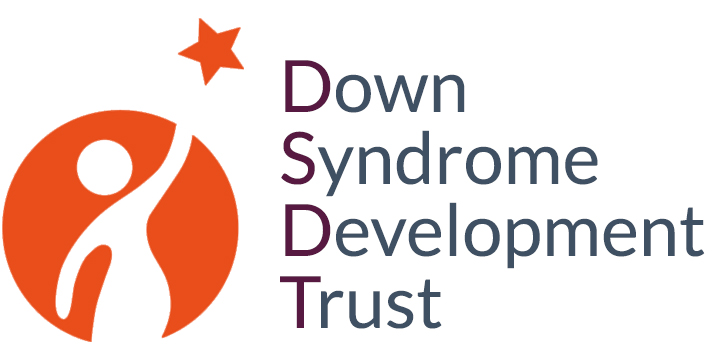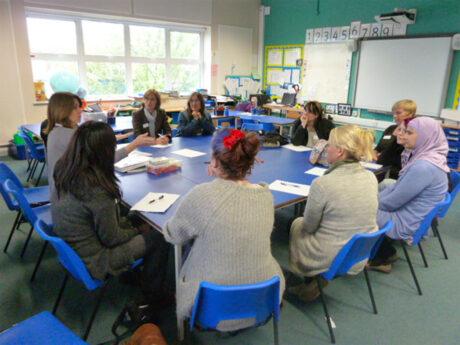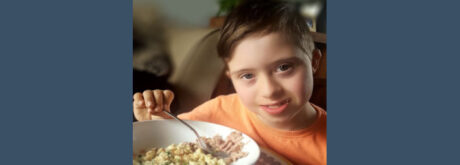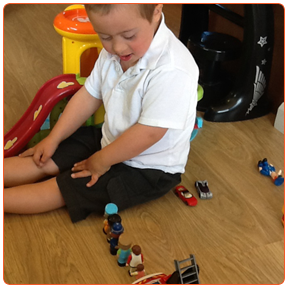
Time I had a calendar…
This leaflet describes how calendars can provide a visual representation of time so you can see timescales like three months, five weeks, six days: they show information that can be difficult to ‘know’ when you hear the words.
Generally we use calendars to back up information that we speak about- we say ‘see you next Tuesday’ and maybe write it on the calendar to make sure we remember the arrangement. This approach uses the calendar to show timescales, and overcome difficulties in using language to talk about timescales.
We suggest thinking about setting up a calendar for children/young people who show an interest in when events will happen, maybe talking about birthdays or outings or film releases, and have awareness of days of the week and months of the year. Maybe get started around the time your child is in keystage 2?
In this approach it’s helpful to use the calendar like a diary that you carry with you and refer to and turn the pages when talking about dates and events, rather than hanging it on the wall.
What we do
- Use a month to view calendar, with weeks in rows and days of the week in columns.
This makes it possible to see weeks, months, and to check out what happens on particular days by looking down the columns.
You can also use templates on programmes like ‘word’ to prepare month to view calendars starting on any month of any year, so you don’t have to wait until the Autumn when calendars come into the shops. (In Word: file>new>templates>calendar wizard. After working through the calendar wizard, you will need to change the font size and include gridlines in the table).
Personalised calendars can increase the young person’s motivation to get to grips with the challenge of learning to use the calendar. Buying a calendar that relates to the individual’s interests can help to make the calendar interesting- but beware of the pictures taking over (we found a Harry Potter calendar with a ‘too scary’ picture of Voldemort that meant we couldn’t look at the November page). Or make up a calendar that reflects the young person’s interests and styles: use colour, fonts, maybe add pictures.
Calendars that sometimes have the last days of the month in the top row (so all the days of the month can fit into five rather than 6 rows) can be confusing.
- Write important events on the calendar e.g. family and friend’s birthdays, Christmas, Bonfire Night, pancake day, holiday in Spain, half term.
You could use written words and/or small drawings (e.g. birthday cake with written name) and/or stickers.
Write events on the squares for the day when they happen, rather than using arrows to block out periods of time e.g. write ‘half term’ on each weekday of half term, or ‘caravan in New Forest’ on each day that the young person will be there.
- Use the grids on the calendar to look together at the time difference between two points on the calendar.
Talking about timescales can be confusing because the language changes all the time: for example, Q. ‘how long is it till my birthday?’ A. it’s not for a while yet, it’s in three months… six weeks till your birthday… 12 days and then it’ll be your birthday… you just had it, it’s not your birthday again till next year… This can be confusing!
The calendar shows that the date of the event (e.g. birthday) stays the same, and ‘today’ is the reference point that changes.
One square= 1 day
One row of squares, or part row of squares= 1 week
One page, or part of one page= 1 month.
We focus on approximate timescales that relate to the calendar- for example, we count months in terms of the number of pages we turn. So if ‘today’ is late April, and we’re checking out how long it is till school trip at the beginning of June, we would say ‘it’s two months till school trip’, because we turn two pages to get to it, although technically it’s only a month and a bit.
- The first step is always to locate TODAY, before you locate the date of the event you are talking about.
First find the page for the month. I ask ‘what month is it?’ and we say/sign the month. Then we find it on the calendar: starting with January, turn the pages and name each month until we get to this month.
Next find the day. I ask, ‘what day is it?’ and we say/sign the month. Then we name the days across the first row of the calendar grid, naming each day until we get to today’s day of the week.
Then find the date. I read out the dates for this day of the week during this month and point to the squares e.g. is it the second? is it the ninth? is it the sixteenth? is it the twentythird?
It’s helpful to refer to the date written down, if you can find it on the whiteboard or the young person’s mobile.
Check and/or teach knowledge of the days of the week and months of the year, and awareness of numbers to at least 20, as needed to use the calendar.
Calendars can be successfully used in this way by people who don’t count all the way to 31.
Don’t worry about teaching ‘ordinal’ numbers like (first, second, third, fourth…. twenty seventh), but use these when you speak about dates. Young people often start out talking about ‘Tuesday one February’ and ‘twentyeight May’ and later learn to say ‘first’ and ‘twenty eighth’ from hearing other people.
- The next step is to locate the date of the important event (which you have already marked on the calendar).
First check out together, did it happen before or is it going to happen?
If it’s going to happen, then you need to search forward from today.
If it happened before, then you need to search back from today.
Look through the calendar together until you find the event. (You don’t need to read off the date of the event unless the young person is interested to do so).
- Check and describe the timescale between today and the event.
Ask the young person to point to today with one hand, and find (point to) the date of the event with the other hand. Give hand over hand support to achieve this.
Then count the days, weeks or months (as appropriate to the timescale) between today and the event. The young person will probably take their fingers off the squares you have found together, so you will need to help with this.
We use:
- a pointing index finger to count and indicate days (squares on the calendar)
- pointing index finger on each hand starting together and moving apart to count and indicate weeks (a row of squares on the calendar)
- a flat hand making small circular movement to indicate months (a page on the calendar).
It’s helpful to count both days and weeks, or both weeks and months so that the young person learns how these timescales relate to each other, e.g. it’s three weeks till you birthday, how many days? It’s seventeen days till your birthday.
- Use set words and phrases to simplify the language learning
These lists identify words and phrases that may be easiest to learn first and equip you to talk about timescales without including more tricky concepts, we suggest you avoid using them when you get started and leave them to learn later.
| Prioritise to learn and use | Words and phrases to leave to learn later |
Day(s) e.g. what day is it? Week(s) e.g. how many weeks till half term? Month(s) e.g. which month is your birthday? Number for this year e.g. 2011- ‘two thousand and eleven’ Days of the week: Monday Tuesday Wednesday Thursday Friday Saturday Sunday Months of the year: Jan Feb Mar Apr May Jun Jul Aug Sep Oct Nov Dec
Ordinal numbers for date: first, second, third, twentyfifth etc. Yesterday, Today, Tomorrow, this week, this month. In # days/weeks/months (future) 3 weeks till school finishes (future) # days/weeks/months ago (past) First and next and then e.g. Can Tracey come to the school play? No, first it’s the school play and next it’s Christmas and then Tracey’s coming to stay.
| What day of the week is it? Fortnight Year(s); numbers for other years Weekdays and weekends
Seasons Spring Summer Autumn Winter ‘The day before yesterday’ Last week, next month Before and after e.g. the school play is before Christmas and Tracey is coming to stay after Christmas. |
- Set up next year’s calendar before the end of the year
You’ll need to get the next calendar set up several months before it starts, so that you can talk about future events together. The young person may carry two calendars for a while (like this years diary and next year’s diary), or might keep the calendars in a filofax-style system where you can add and remove pages.
Secondary schools might consider including month to view calendar pages in school planners.
Notes you might attach to the calendar
When you use the calendar, always start of by finding ‘today’.
- Turn to the correct month
- Find the column for the day of the week
- Look down the column for that day to find the correct date.
- Say the date: today is (Monday the 20th of September). Point to the writing on the calendar for the day, date and month.
Always write on new information with the pupil, so that they see you add the recording or write it themselves. Draw pics or add stickers for words that are difficult to read e.g. you might put a star sticker next to ‘auditions for school show’.
After you write anything on, then check timescale relative to today: that’s in three months (turn the pages to count); that’s in two weeks (move and count down two rows on the page to count).
If there are changes to dates, then show the pupil how to change the recording e.g. say, the date of our party has changed. It was on 14th Dec. Let’s cross that out. It’s on 16th Dec instead. Let’s find 16th Dec. Let’s write on, ‘Christmas party at youth club’.
Write on regular events like swimming lessons, but also write on when these are not scheduled to happen on their usual day. E.g. if swimming lessons take place most Tuesdays but there is no swimming lesson on Tuesday 8th May, then write ‘no swimming lesson’ on that date. The calendar shows school dates, add in ‘back to school’ and ‘last day of school’ on planned dates for pupil (e.g. if holiday dates overlap with termtime).
Write on birthdays, including the pupil’s birthday, choosing friends birthdays to include, and family birthdays if the pupil wants to include these.
Notice and write on ‘last’ days, as well as ‘first’ days. E.g. if you write ‘Josie goes on holiday’ on the first day that Josie will be absent, then write ‘say goodbye to Josie’ on the last day that the pupil will see her.
Add any date-related information that is important to the pupil e.g. If the pupil is excited about a new film coming out and finds out what date it will be released to cinemas, then write that date on ‘Harry Potter 7 film release’, or if pupil is a big fan of Zac Efron and checks out his date of birth, then include ‘Zac Efron’s birthday’ (it’s on 18th Oct).
Teaching language to talk about calendar time
First-next-then
Use ’first-next’then’ to talk about key steps, that are important to the young person, in very familiar, unchanging routines e.g. at break time: first you eat your snack, next you can play a game, and then you pack up and go to your next lesson
Days of the week
Draw up a chart identifying a key event that usually happens on each day of the week
e.g. Monday- swimming, Tuesday-Janie goes to Brownies, Wednesday-mum goes to work, Thursday- cooking in food tech, Friday- fish and chips for tea, Saturday- drama club, Sunday- no school no clubs
If there are some days that don’t have routines associated with them, you might need to set up a routine for that day e.g. Tuesday- tidy your locker, Friday- phone Tom at Uni.
If a ‘usual’ event doesn’t happen on the usual day, then you just explain this e.g. It’s Tuesday. Janie usually goes to Brownies on Tuesday. She’s not going to Brownies this week because we’re going to visit grandma in hospital.
You could make up a book or poster or powerpoint presentation with the young person showing their days of the week routine and practice this.
Alongside this, practice reciting (speech and/or sign) the days of the week: Monday, Tuesday, Wednesday, Thursday, Friday, Saturday, Sunday.
Months of the year
Learn the days of the week and make sure the young person is really secure with these, before working on months of the year.
Use the same process as for learning about days of the week.
e.g. January- back to school, February-Valentines Day, March- Joe’s birthday, April- Sophie’s birthday, May- summer half term, June- your birthday and mummy’s birthday, July- say goodbye to your old class, August- no school, September- start your new class, October- Halloween, November- Bonfire night, December- Christmas.
Happened before/going to happen
Collect together pictures/leaflets about upcoming events and put them in a ‘going to happen’ file or box e.g. party invitations, leaflet for farm to visit on school trip, brochure for your holiday destination, copy of poster for school show. Sit down together once a week or so, and talk about all the things that are ‘going to happen’. You can use the sign and symbol for ‘going to’, as visual supports.
Set up a different file or journal or scrapbook to record things that ‘happened before’, and move your pictures/leaflet into this after the events happen. You can add more souvenirs collected at the event e.g. postcard from holiday destination with one page from the brochure, photo of your child in costume to go with the poster for the school show. Move the items across, and talk about things that ‘happened before’ at your chat-and-review sessions. You can use the sign and symbol for ‘past’ as visual support. You might include some writing about the event.
© Symbol UK Ltd 2011




